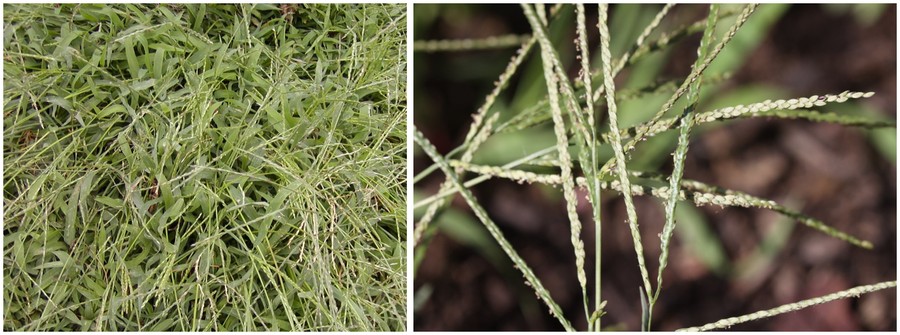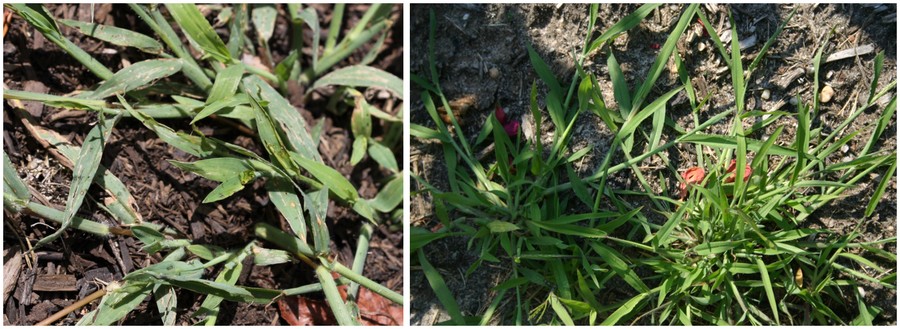Tips to Control Groundcovering Mint Weeds
Hand pull repeatedly and consistently, aerate and enrich soil with calcium and more fibrous humus, decrease irrigation, plant vigorous competitors, or if you can’t beat ‘em, eat ‘em. Caveat: be sure of their identity first before you consume them.
Grassy, Monocot division, invaders hide more easily amidst the grasses of the lawn.
Legions of weedy grass varieties invade lawns. They usually sprout at a faster pace than grass cultivars, tolerate tougher soil with a wider range of conditions in terms of heat, shade, water, and nutrition levels. In fact, they compete best in conditions that starve out the cultivated grass. This creates different heights, leaf shapes and colors and perhaps brown patches in the lawn in winter when cool-season grass stays green or vice versa (in the droughtier south and west). These weeds make the lawn look shaggy, patchy and irregular. You will come to recognize the invaders you dislike in your lawn over time.
Crabgrass and Wild garlic grasses in particular seem to grow everywhere and provide a good starting point.
Vast numbers of weed seeds from Crabgrass, Digitaria spread in the lawn as we mow. Crabgrass doesn’t even hide its seedheads. At first, Crabgrass sprawls out in full sun and stays low, but as it ascends with a more rapid growth rate than seems possible, it quickly looms above the slower-growing cultivated grasses. These finger-like flowering spikes, just covered in seedheads, contain and protect more seeds than you can see with the naked eye. The wind and lawnmowers help sow its seeds.

Left: Crabgrass seedheads in lawn before mowing Right: Magnified Crabgrass seedheads in “bloom”
Each Crabgrass blade (“culm” in grass botanical language) can form “tillers”, or adventitious roots to sprout clones, very much like Ground ivy’s “stolons”, wherever it touches ground. It can re-generate from bits of roots, tillers, or blades left behind. Its shallow roots grow more rapidly than do those deeper rooted perennial Grasses usually selected for building a lawn.

Left: Parallel leaf veins and stolons on Crabgrass Right: Crabgrass forms a stoloniferous colony in impoverished soil
Crabgrass prefers barren, hot, compacted spots where competition is low and where its specialized photosynthetic ability2 puts it at an advantage vs. other plants. Some gardeners leave the Crabgrass alone to allow a drought stricken or heavily compacted yard to at least remain green in the summer. Come the fall, the lawn will turn brown where the Crabgrass leaves the lawn patchy. This becomes less problematic with Zoysia and Bermuda grass which also turn brown come the frosts. Zoysia and Bermuda grass selections suit lawns further south or out west where temps stay too high and weather stays too droughty in summer for Kentucky blue, Tall fescue, or other cool-season cultivated grasses.
2 As a C-4 photosynthesizer Crabgrass photosynthesizes at higher temperatures, with rates that are 2 to 3 times higher than those of C-3 cool season plants. When both grow in a hot droughty environment, cultivated cool season C-3 Grasses lose almost 3 times the amount of water, per carbon dioxide molecule fixed, than Crabgrass does. C-4 plants require less nitrogen, a key lawn fertilizer, in its process. The C-4 plants theoretically evolved as Grasses moved to more sunny and droughty plains and out from the shady richer floors of forests.